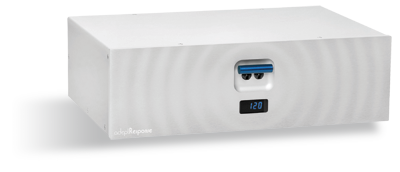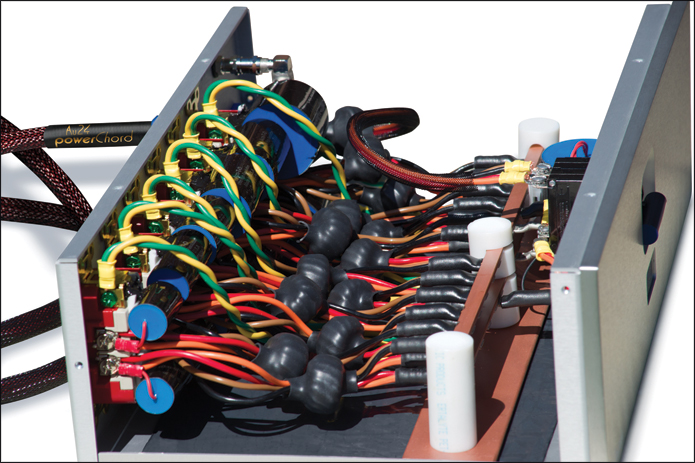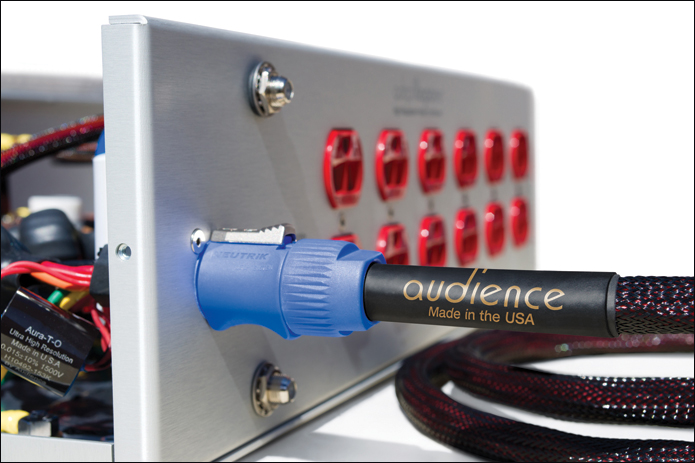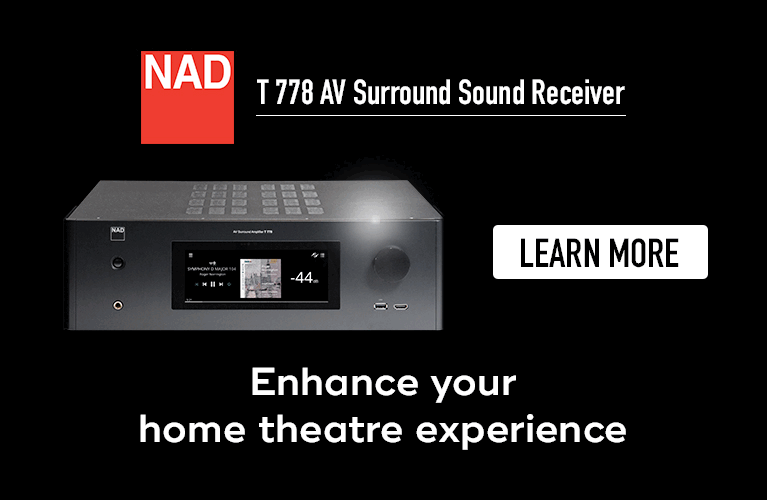 If your system has a total retail value of under $10,000, a power conditioner costing $9000 has got to seem downright silly. But continue reading -- I promise you’ll learn something useful. But if your rig cost north of $30,000 and you’re not using any power conditioning, well, you keep reading, too: power conditioning is where you need to make your next upgrade.
If your system has a total retail value of under $10,000, a power conditioner costing $9000 has got to seem downright silly. But continue reading -- I promise you’ll learn something useful. But if your rig cost north of $30,000 and you’re not using any power conditioning, well, you keep reading, too: power conditioning is where you need to make your next upgrade.
Description
My main audio rig already includes more than enough electronic boxes, and the Audience aR12-TS power conditioner is another one. It costs $8995 USD with stock cord, or $10,545 with Audience’s Au24 e powerChord. The aR12-TS is a large, silver-anodized box about the size of my old Kenwood KT-8300 tuner: 17”W x 5.25”H x 11.4”D. There’s no tucking it in neatly behind a rack -- it takes a shelf on the rack, folks. But the aR12-TS’s total of 12 outlets means you can -- and should -- plug your entire system into it, so it’s easy to justify making enough space for it. Its appearance is nondescript, other than the cool blue magnetic circuit breaker on the front panel, which turns the power on and off. The Audience’s case made a slightly audible resonance when tapped, but on the whole it felt solidly built. In offering a ten-year warranty, Audience clearly intends to stand behind the aR12-TS -- but heck, with a passive box housing only some capacitors, inductors, and copper bus bars, there’s not much to break.

Each of the aR12-TS’s outlets has both an inductor and an Audience Teflon capacitor for filtering purposes, but the caps vary in size; the smaller values are to be used with low-current digital gear, the larger with analog gear -- and the largest for your power amp(s). Capacitor networks are frequently used to damp ultrasonic noise and ringing in electrical lines: in a common-mode network, the cap is connected between neutral and ground; in normal mode, between hot and neutral. The only difference between the aR12-TS and the aR12 ($4995) is the use, in the former, of Audience’s excellent and expensive Aura-TO Teflon capacitors, instead of the latter’s Auricaps. But Audience didn’t send me an aR12, so I couldn’t compare the two versions.
The outlets are copper-and-brass Hubbell duplexes with their typical snug, reassuring grip. Inductors electrically isolate each outlet of each pair from its partner and the other ten outlets. Audience claims that their inductors cause no significant series resistance, which I sincerely hope is true -- in my experience, inductors generally narrow dynamic range. Audience claims that the aR12-TS also performs partial Power Factor Correction; I’ve read that when your house’s voltage and current are out of phase, your system’s Power Factor is compromised -- you require more power from the wall to do the same work. Anything that brings the voltage and current back in phase should result in improved dynamics.
One neat feature on the front panel is a small digital screen that displays the incoming voltage. This let me confirm that, from September through November, my incoming AC voltage never deviated from 120V by more than +/-2V, which made me skeptical that voltage fluctuations were compromising my system’s sound.
The aR12-TS’s stock power cord was perfectly adequate, but it sounded better with the Au24 e powerChord, so that’s what I used.
Listening
When evaluating power conditioners, I’ve found it best to focus on the three areas where, in my experience, they typically most affect the sound: resolution, tone, and dynamic range. Sure, some conditioners -- specifically, those based on isolation transformers -- will extend the depth of the low bass, but deep bass won’t matter a lick if it comes at the costs of lower resolution, a skewed tonal balance, and/or constrained dynamics. Folks, if the power conditioner you’re listening to improves resolution, tone, and dynamic range, you’re listening to a good power conditioner.
And when you install a good power conditioner, you’re generally rewarded with greater retrieval of detail. The Audience aR12-TS delivered that in a big, big way. During my first 100 hours with it, before I did any serious listening, I found myself, for the first time, following the words of “Seer,” from the Brian Jonestown Massacre’s We Are the Radio (CD, Tee Pee TPE062). With the aR12-TS feeding the whole system, the female singer’s voice was rendered with those minute fluctuations in pitch and phrasing that are part of normal conversation, but are seldom heard in home stereo playback. Those microdetails are typically obscured below an audio rig’s noise floor -- but if you lower the noise floor, you hear them.
In the absence of a good power conditioner, one adjusts to a higher noise floor the way one adjusts to a narrow soundstage or a missing bottom octave: it’s just part of the sound one has, and one listens around it -- until one doesn’t have to. If the Audience was the most resolving power conditioner I’ve used (and it was), then it has to be said that my system’s noise floor was never lower than when the Audience was feeding all my electronics.
While I’d never been conscious of any noise floor in my rig before the Audience, the thing about a noise floor is that you almost never are conscious of it -- until it goes away. It’s like getting a new prescription for your eyeglasses when you thought you didn’t need one, only to find that you did. The noise floor of a system is just white noise that rides on the signal, obscuring micro-inflections -- as in the singer’s voice in “Seer.” When I was listening to “The Night They Drove Old Dixie Down,” from the Jerry Garcia Band’s Pure Jerry: Bay Area 1978 (Jerry Garcia Family JGCD-0009), the unmiked yells and whoops from the audience were now clearly audible: a random “Woo!” or “Yaah!” from an off-mike voice, defined in space forward of the stage. While I’d never argue that audience noise is important to the music, the fact that I heard it so clearly rendered for the first time should indicate how revealing my system now was. The Audience aR12-TS was a resolution champ.

As I continued listening, it became clear that the Audience’s levels of midrange and lower-treble resolution were standard-setting -- again, that vanishing noise floor paid big dividends in the listening chair. Listening to Phish’s concert of April 3, 1998, at Nassau Coliseum on Long Island (www.livephish.com, PA1002LP), I got incredible insight into the amazing cymbal work Jon Fishman peppers in between “Nassau Jam” and “Piper.” Digital playback normally receives and deserves demerits for upper-midrange glare: midrange and treble harmonics moosh together into a homogenized hodgepodge of excess energy that both smears information and, when severe enough, causes listening fatigue. This was never a problem with the aR12-TS. The upper midrange and lower treble were nuanced, finely shaded, and highly resolved, presenting harmonic decay and inner detail that I’d never heard with any other conditioner.
But such reference-caliber retrieval of detail would be only a parlor trick had the aR12-TS not also delivered an accurate tonal balance. Moving on to another Jerry Garcia Band album, Let it Rock: The Jerry Garcia Collection, Vol.2 (CD, Rhino JGCD-0010), “Pig’s Boogie” and “Lady Sleeps” stood out for Nicky Hopkins’s intricate piano work, which the Audience fully revealed. The decays of the piano’s upper registers, previously obscured by a fine layer of glare, were more fully illuminated and harmonically developed with the aR12-TS in the system. I felt I could see into the lowest, previously obscured levels of harmonics of pianos, guitars, cymbals, and even voices. Piano lovers will love what the Audience does.
One thing I can’t explain: With the aR12-TS feeding my system, it sounded louder at the same volume setting. Listening to “Wasting Time,” from Jack Johnson’s classic On and On (CD, Universal 440 075 012 2), I found I had to turn the volume down five increments on my Herron VTSP-3A line stage -- perhaps an effect of the Audience’s Power Factor Correction? I’d never experienced a conditioner that targeted improving the Power Factor, nor any conditioner that made my system sound louder. Sure, I’ve listened to components so tonally objectionable that sheer listening fatigue made me turn the volume down, but that wasn’t the case with the aR12-TS. Music was simply more dynamic and propulsive through it, while also having that reference-caliber resolution. Kick drums had more snap, and better-defined transients. While some gear hypes the leading edges of midrange and treble transients, it eventually causes listening fatigue, as those leading edges are not consistently reproduced across the entire audioband. In contrast, a good power conditioner that consistently reproduces leading edges properly will also do so in the bass, and the aR12-TS did. Through the aR12-TS, the kick drum in “Home,” from Edward Sharpe & the Magnetic Zeros’ Up from Below (CD, Community/Vagrant VR 542), had a speed and definition I hadn’t heard before, but the same pace and attack as the rest of the audioband.
Lower frequencies were handled with the same resolution and definition as the mids and treble, and were presented with a depth that was seamlessly woven into the overall sound. Listening to “Camarillo Brillo,” from the re-remastered edition of Frank Zappa’s Over-Nite Sensation (CD, Rykodisc 1443-10518-2), I noted that Ralph Humphrey’s kick drum was more textured and had a hollow feel to it through the aR12-TS, while never coming across as hollowed-out or thin. When a kick drum is struck, the transient attack of the sound is followed by the pitch of the instrument, then the decay of the musical note and the sound of the instrument’s body. The Audience revealed both, letting me hear the depth and decay that are part of a kick drum’s total sound. That’s what the bass had with the aR12-TS: transient fidelity, resolution, and acoustical depth.
Comparisons
I directly compared the Audience aR12-TS with another power conditioner that could find a home in most any system, and has in mine: Weizhi Precision’s PRS-6 ($3200). Both are passive conditioners, so it’s not surprising that I found they sounded more similar than different. While marginal differences define the high-end experience, it took some careful listening to tell these two apart.
The Audience aR12-TS had the better midrange and lower-treble resolution, and was the only one of the two to make my system sound louder. Listening to “Bag’s Groove,” from Jerry Garcia and David Grisman’s So What (CD, Acoustic Disc ACD-33), I found in A/B comparisons that the Weizhi had better top-end extension and energy, and perhaps a smidgen more physicality and extension in the bass. But the Audience was superior at harmonic development from the upper bass to the low treble, letting me hear more of each instrument’s full harmonic envelope in this critical region. Furthermore, the aR12-TS noticeably lowered the noise floor, letting me listen deeper into the music, to hear more decay and inter-note separation along with superior placement of performers on the soundstage.
Soundstaging was more of a contrast: The aR12-TS’s superior resolution was accompanied by a mid-hall stage presence, whereas the Weizhi was more forward and front-of-hall (see below). However, in comparing the two models’ dynamic range while listening to “Moby Dick,” from Led Zeppelin’s How the West Was Won (CD, Atlantic, 83587-2), I’d have been hard-pressed to reliably tell them apart. Perhaps -- perhaps -- the Audience had a bit better transient definition; but the Weizhi may have been slightly better at follow-through impact.
Further listening let me focus more on tonal differences, which, along with soundstaging, were the points of greatest contrast between the Weizhi and the Audience. About a minute into “Monkey Beams,” from Cal Tjader’s Soul Sauce (CD, Verve 314-521-668-2), Donald Byrd’s trumpet enters in the right channel. Through the Weizhi, the trumpet had fewer inner harmonics in the upper treble, which rendered the horn’s tonal envelope more homogenized; the aR12-TS was able to fully flesh out all those little fluctuations in pitch that are seldom heard with digital playback -- or any playback, for that matter.
The Weizhi Precision PRS-6 had the better extension at the frequency extremes, but a slight homogenization of upper-midrange/low-treble tonal energy and a more forward sound that were clearly inferior to the aR12-TS. The Audience had fantastic resolution from upper bass to low treble, but less air, extension, and energy at the top end, while missing a bit of the follow-through of deep-bass transients.
Conclusions
Any power conditioner -- like any speaker cable or interconnect -- will do some editorializing on the sound. What matters is finding one that’s synergistic with the sound of your system. When I owned Wilson Audio WATT/Puppy speakers, I got terrific sound with Kubala-Sosna Emotion cables; tonally rich and rolled off in the highs, they nicely complemented the Wilsons’ aggressive top end. When I switched to AudioQuest’s far more transparent and dynamic Redwood cables, the balance of my rig’s sound became annoyingly edgy. But the Redwoods are a great match for my current main speakers, Rockport Technologies’ Merak 2 / Sheritan 2. With the Audience aR12-TS feeding my whole rig, the sound is more dynamically propulsive, with excellent resolution, and a tonal balance that doesn’t draw attention to itself. It’s easy to enjoy listening with the aR12-TS.
I’d never elevate a power conditioner’s importance to that of electronics or speakers. Let’s face it: It’s outside the signal path. If you’re deeply dissatisfied with the sound of your rig, dumping a big chunk of your budget into a power conditioner isn’t a good idea -- change your rig, then address your AC. However, if you’ve got a well-tuned system that’s musically satisfying and you face a choice of upgrading to a $1000-$3000 CD player or adding a good power conditioner, I suspect you’d be more benefited by the latter. And the better your electronics, the more you’ll hear the effects of a good power conditioner.
The Audience aR12-TS is a good power conditioner. A damn good power conditioner. I could live happily with it, so little editorializing does it do. I wouldn’t hesitate to plug an entire rig -- up to a dozen components -- into it, confident that I’d be feeding each of them quality power. If you’re in the market for a single product to provide excellent power for a large system, the Audience aR12-TS is an easy recommendation.
. . . Ryan Coleman
ryanc@soundstagenetwork.com
Associated Equipment
- Speakers -- Rockport Technologies Merak 2 / Sheritan 2
- Preamplifiers -- Herron VTSP-3A, Ypsilon PST-100 TA
- Amplifiers -- McIntosh MC-501 monoblocks, Edge Signature NL-12.1
- Sources -- Sony XA-5400ES CD player with ModWright Truth Mod, Esoteric K-01 SACD/CD player
- Cables -- TG Audio interconnects and power cables, AudioQuest Redwood speaker cables
- Power conditioners -- Weizhi Precision PRS-6, Oyaide R1 and WPZ wall plates, TG Audio Power Strip, dedicated lines, Maestro AC outlets
Audience aR12-TS Power Conditioner
Prices: $8995 USD; $10,545 with 6’ AU24 e powerChord AC cord.
Warranty: Ten years parts and labor.
Audience AV
120 N. Pacific St., #K-9
San Marcos, CA 92069
Phone: (800) 565-4390
E-mail: info@audience-av.com
Website: www.audience-av.com






















